03.14.2011 | 4:57 am
A Note from Fatty: This is going to be an intense week, work-wise. Luckily, several readers have stepped up and sent in some fantastic stories for me to publish. As a result, I think you’ll find that this week is going to be awesome, content-wise.
About the Author of Today’s Post: Moishe Lettvin writes code, rides his bicycle, runs and can’t wait to take his daughter adventuring on two wheels. He’s on the web at http://profiles.google.com/moishel.
When I was a kid I was, to put it mildly, not very athletic. Whenever I played a sport involving a ball, the ball would hit me in the face; whenever I played a sport involving speed, I was slow. This bothered me but only in a vague way; I was more interested in other things, primarily computers. I felt like I was pretty good at that and if I couldn’t run a mile and a half during gym class, oh well.
Junior year of high school, my friend Mark and I were sitting in the cafeteria during study hall, likely struggling with our French homework. Mark looked up and said something off-the-cuff and probably not very serious.
He said, “Hey Mo, after we graduate, let’s ride our bikes to California.” As I remember it this suggestion was completely unexpected; it’s not like we spent lots of time riding our bikes around or talking about the sunny climes of California. Maybe it arose from the general wanderlust of teenage boys or a sense of confinement in our small suburban town, or… well, who knows. It changed my life.
I became obsessed. I started riding my bike, a heavy Schwinn Continental, all around the back roads of eastern Massachusetts and southern New Hampshire. That summer, the summer between my junior and senior year, I rode to the beach in Gloucester; I rode along the Merrimac River; I sought out the steepest hills I could find so I could bomb down them.
I saved up the money from my job — at a local software company, natch — and towards the end of summer bought myself a bright red Cannondale, equipped with racks and low gears, perfect for long-distance touring.
I went back to high school that fall 40 pounds lighter and almost unrecognizable from the pasty nerd of the year before. I was more distracted than ever from my classes; I spent my time daydreaming about being on the road and the feeling of setting out for an adventure to the other coast. I spent every calculus class doing math, yes, but not calculus.
“How many miles a day will I have to ride to get to California in 3 months? How much water will I need to carry? I wonder how many flat tires I’ll get?” I got rollers later that fall so I could keep riding when the snow fell, and I rode through the winter mostly in my bedroom. Occasionally I’d venture onto the messy roads, ending those rides by chipping frozen slush off my down tube in my parents’ garage.
Spring came and the snow melted and I easily fell back into the rhythm of watching the sun rise on my weekday rides and seemingly endless rides on the weekends. I graduated high school – barely – in May and spent the summer writing software and riding my bike to the exclusion of pretty much everything else.
What about riding to California? Isn’t summer the time to do it?
Well, yeah… but Mark couldn’t go. So I fell back to the BikeCentennial classifieds to find some riding companions, and found three people who wanted to leave from New England around Labor Day. We exchanged mail (actual physical letters — this was a long time ago) and phone calls and planned to meet at my parents’ house the day before Labor Day, figure out last minute logistics, and set out the next day.
So plans were made. I was riding to California! All I had to do until September was ride, and ride, and save some money. I did that.
Around the middle of August, I set out kinda late in the day for a long ride. I’ll bet — though my memories are hazy now — I rode out to the coast in Manchester, past the tourists buying antiques in Essex, through the rolling farmland in Ipswich and Rowley. I probably got a snack in Newburyport. I may have continued north into New Hampshire, or looped over towards Haverhill, but I know that by the time I got back onto the long, empty stretch of route 1A heading back from Crane’s Beach in Ipswich towards my parents’ house, it was dark.
It was dark, and I might’ve been worried by that, but it was one of those summer nights that people write songs about. If you’re from the northeast, you might know what I mean: the warm air, crickets, stars and moon hazy with humidity. There was no traffic. I’d ridden close to 100 miles and nothing hurt; indeed I felt as good as I ever had in my life.
I took my hands off the bars, sat up and let the warm air wash over me. I thought of adventures to come. I thanked whoever came up with the idea of balancing on two wheels. I thanked Mark for the crazy idea to get on a bicycle and start riding, ostensibly to California, but really just to ride. I thanked my parents for being so willing to let their kid take off on some crazy adventure. I thanked my muscles and bones and tendons for adapting themselves so ably to what I asked of them. I thanked myself for not letting the images I and and others had of me – fat, not athletic, a computer nerd – get in the way of something magical.
I might have teared up with gratitude and happiness and a touch of pride, but it was probably the wind.
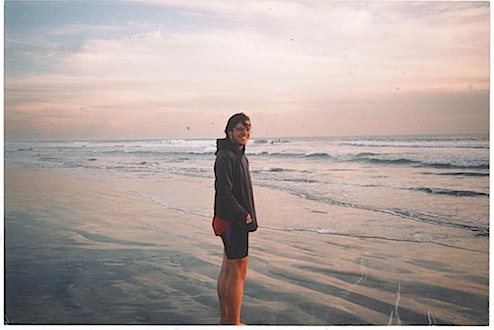
Comments (45)
03.11.2011 | 1:56 pm
A Mysteriously Exciting Note from Fatty: I very nearly have something very exciting to announce. I cannot (or at least am unwilling) to tell you what it is quite yet because I have not nailed down the exact date and time, but here are some hints:
- It has to do with this blog.
- It will happen soon.
- You will be able to participate, and it won’t cost you anything.
- Johan Bruyneel will also be participating.
More details soon. As in, early next week.
This Blog Ain’t Going to Write Itself
As you probably know, writing this blog has made me fantastically wealthy. So wealthy, indeed, that I really have no need to have a day job. Like most extremely wealthy (and handsome) people, I continue to work a 9 – 5 job strictly because I find it fulfilling at a personal level.
As part of my day job (the one I do even though I have no need whatsoever of money), I have weeklong meetings, twice per quarter. During these very intense weeks, I have pretty much no mental energy or creativity for anything but my job itself.
For the past year or so, I’ve mostly just not posted during these very intense weeks, or have posted very short things. Or have dipped into my (small) reserve of things I’ve written but have not yet posted. Or have re-posted stuff from long ago.
But here’s the thing: these twice-per-quarter weeklong meetings aren’t going away anytime soon. And I don’t like to just let my blog sit here, languishing, during those weeks.
And last night, a solution came to me: ask you to write guest posts about a certain theme while I’m doing these weeklong meetings. I mean, you’ve got stories to tell, and I’ve got a place to tell them. We should work together.
So, if you’d like to write a post for my blog, here’s what you’ve got to do:
- Keep your story to under 1000 words. And don’t write a 2000-word story with a suggestion that I use it as a two-parter. Because I won’t. On the other hand, if your post is way under 1000 words, that won’t count against you. Like, if you have an awesome photograph and a one-paragraph story, that may just work. As long as it sticks to the theme.
- Stick to the theme. If your story isn’t about the theme for this week of guest posts, or if it’s only tangentially related and I have to squint real hard to see how it fits in the theme, I won’t use it. The theme for this week is, “My proudest moment on my bike.“
- I want original content. Don’t send me a link to something you’ve written for your blog a couple years ago. Write something new.
- Send it in on time. I need your posts by Monday, March 14. Send it to fatty@fatcyclist.com with the subject line “Guest Post.” I know I haven’t given you a lot of time to write your story, but bear in mind that I never give myself a lot of time to write anything, either.
- Send the story as an email message. You can write your story in whatever you want, but copy and paste it directly into the email message, so I don’t have to open up whatever program you use to write in order to read your story.
- Send images as JPG or PNG attachments, 495 pixels (or more) wide. If you send any images in a format that requires me to do as much work as if I would have just written the story myself, I’m not going to use your story.
- Make sure you give me a bio you want me to use. I’ll be happy to link back to your blog or website in your bio, and I’ll use either the name or the handle you include in your bio. Your choice.
- Watch my site next week. That’s how you’ll know whether I decided to use your story. If I use your story, it’d be cool if you monitor the site a lot during the day to respond to comments readers have.
- If I don’t use your story, don’t be mad. I doubt I’ll be able to use all the stories that come in, and just because I don’t use yours doesn’t mean it was no good. It just means that I got had already picked the stories I wanted to use before I read yours.
Finally, please be patient. This is kinda new, so I don’t know how well it’s going to work out. But I’m excited to read — and post — your stories.
Comments (8)
03.10.2011 | 2:19 pm
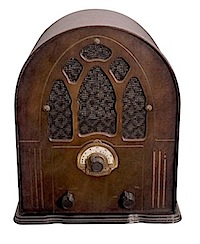 A Note from Fatty: This is the third in the occasional “The Fat Cyclist Explains” series, which goes to show it really is a series, albeit a sporadic one. You can read the first installment here, and the second one here. Finally, you can read the third one here, but you’re already here, so what’s the point of clicking this link? I don’t think there is one, to be honest.
A Note from Fatty: This is the third in the occasional “The Fat Cyclist Explains” series, which goes to show it really is a series, albeit a sporadic one. You can read the first installment here, and the second one here. Finally, you can read the third one here, but you’re already here, so what’s the point of clicking this link? I don’t think there is one, to be honest.
A couple of days ago, I remembered, briefly, that I have an email address and that many people actually read email that comes to them. For the novelty of it, I opened my email (note to the 14,000 people who have sent me as-yet-unread messages: I’ll get back to you soon!). To my delight, I found I had just sent myself the following email:
Dear Fatty,
I’ve been seeing a lot of headlines in the cycling press about a controversy surrounding the banning of race radios. I don’t want to read the articles myself, so I was hoping you could explain — in the objective, clear and thorough manner for which you are known — what this this ban means, who’s for it, who’s against it, why it matters, and what it means to the future of the sport.
Thanks very much for your very informative, entertaining, and award-winning blog,
Duane
Thanks for your note, pretend person whom I choose to call “Duane!” As you’ve noted, there is in fact a controversy over the use of radios in professional cycling. I’ll do my best to explain what’s going on.
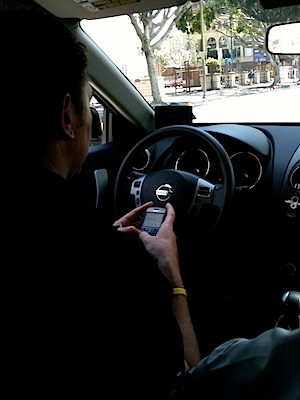 What Are Race Radios, and What Their Problems?
What Are Race Radios, and What Their Problems?
It’s quite simple to define what a “race radio” is, actually. It’s any radio that is used to communicate with cyclists during a bicycle race. Due to the wide variety of ways in which a radio can be used, many problems — some intentional, some accidental — can occur.
Let’s go through some of the most prevalent.
Dangerous Directors: The primary — and by far the most dangerous — problem with race radios is the fact that race directors are incredibly frightening drivers. Trust me; I’ve ridden with one. They’re talking (and texting) on their phones. They’re looking at maps. They’re looking at watts and kilojoules and VO2 max scores and whatnot. They’re consulting with passengers in the cars. They’re handing out drinks.
Meanwhile, if the director ever gets a chance to look out the windshield, he’ll notice that the streets are lined, ten-deep, with people.
With all that going on, is it really a good idea for race directors to be saddled with the additional distraction of communicating with the riders?
That question was rhetorical, by the way.
Cruel and Unusual Punishment: Perhaps even more important than the “menace behind the wheel” issue is the fact that many team directors fancy themselves excellent singers, and will often sing along to whatever they’ve got in the car’s CD player. For example:
- Johan Bruyneel: Known to open up the mic and “treat” the entirety of Team RadioShack to hits from the 80’s, including (but not limited to), “You Spin Me Round,” Round and Round, and — to show his musical tastes are not strictly a product of the 80’s — “I Get Around.” Says pro cyclist Levi Leipheimer, “I suppose I understand Johan’s fascination with “round”-themed songs, but that doesn’t mean I have to like it.”
- Bjarne Riis: During climbing stages, will — a cappella — open up the mic and sing the entire Abba catalog during long, flat stages, just to entertain himself. “The riders love it,” says Riis, citing, as evidence, the fact that he has informed them that they love it.
- Jonathan Vaughters: Vaughters is known for breaking into Riis’ radio channel and joining in for the chorus of “The Winner Takes It All.” Says Vaughters, “I find the song highly inspirational. And besides, Abba is awesome.”
Radio Quality: The truth is that race radios are simply not very good, and it’s very difficult to understand a thing the race director is shouting into the CB-quality microphone. As a result, the second-most-commonly-heard phrase in the peloton is now, “Excuse me?”
The first-most-common phrase is, of course, “What?”
Spoiling the Surprise: Finally — and perhaps most importantly — race radios eliminate elements of the race that would otherwise be very interesting. The most commonly-cited way in which race radios take away the excitement and unpredictability of the race is in breakaways. In the absence of radios, cyclists don’t know exactly how far ahead a break has gone, which means that they can’t let the breakaway get very far ahead.
This means, tragically, that Phil and Paul will have to figure out something else to talk about during an interminably long stage, instead of talking for hours about how perhaps this will be the group that wins the breakaway lottery.
But while breakaways will be given much less line before they’re reeled in, the absence of radios will add excitement in a much more key aspect.
Crashes.
See, one of the things radios are used for is to indicate upcoming obstacles, turns, and the occasional renegade cow on the course. Without radios, racers are likely to crash more often, and — even better — crashes are likely to turn into full-on pileups pretty frequently as well.
Which, as far as I’m concerned, is the very best argument for not letting racers have radios.
Why the Controversy?
So now that you understand the problems of race radios, you are almost certainly wondering why there could be any controversy surrounding the banning of them.
Well, there are two perfectly good reasons.
The first reason is that the UCI is behind the ban, and we have gotten so used to the UCI being completely screwed up in everything they do that we now assume that if they back something, it must be screwed up.
In fact, I’m having a certain amount of cognitive dissonance myself. I’m agreeing with UCI on something? Really? What am I missing? Weird.
The second reason, however, is much more important and practical. Namely, everyone — the cycling press, cycling fans, pro cyclists, the UCI, everyone — is just so happy that we’ve got a controversy to talk about that isn’t doping.
It is so refreshing to have an argument devoid of skullduggery, ad-hominem attacks and innuendo that, even though nobody — pro or con — really honestly feels like the race radio ban is that big of a deal, we’re going to keep talking about it, dwelling on it, and feigning outrage about it.
Although I assure you, my own personal point of view is very, very genuine and I am 100% committed to it and am willing to argue about it until I start to get foamy spittle at the corners of my mouth.
Hopefully, that clears the topic of the Race Radio Ban up for you. I’m glad I could help.
PS: I wish to reiterate that I’m very, very passionate on this subject. Very.
Comments (27)
03.8.2011 | 2:01 pm
I am a sensitive person, and do not like to be the cause of sadness, distress, disappointment, or even melancholy. And so I feel it is my duty to tell you, up front, that while this post is about a product that I really, really like, the post ends on a sad note. So if you don’t like sad things, you should stop now.
If on the other hand, you are into sad things, I should probably point out that on the sadness scale of 0 to Edward Scissorhands , this is probably a 2.
In short, this post ends sadly. But not very. And in the meantime, you’ll learn about something I love: my Pearl Izumi glove / mittens.
[UPDATE: Okay, the sad part is no longer all that sad. So as soon as you're done being sad, you can be immediately happy again. This blog is a huge emotional rollercoaster today.]
They’re Gloves. No, They’re Mittens
The Winter months are difficult for cyclists in cold places. The likelihood of the temperature and weather being the same for the duration of your ride is, well, nil. So you layer up, or at least have layers ready, for when the temperature drops.
As you warm up, you strip down a little. When you get to the top of a climb, you layer back up. If you change direction — so your tailwind becomes a headwind — get ready for everything facing the front to get much colder all of a sudden.
I’m pretty good at this layering business. But what to wear on my hands in cool-to-cold weather has always been a problem. Sure, I can start with a pair of light gloves under heavier gloves, but peeling layers of gloves is not easy.
And re-layering is even harder, especially if you don’t want to pull over and put a foot down.
So I love the solution Pearl Izumi came up with.
[Full Disclosure: I bought these gloves at a bike store and got no special discount on them. Same thing goes for The Runner.]
Here’s the palm view:
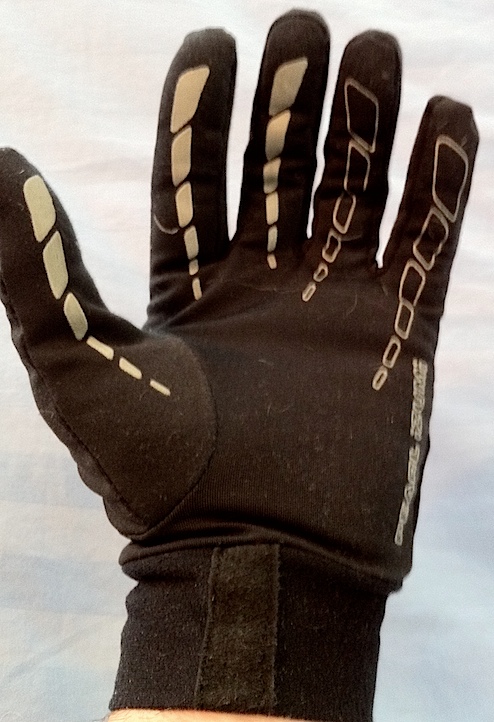
And here’s the back-of-hand view:
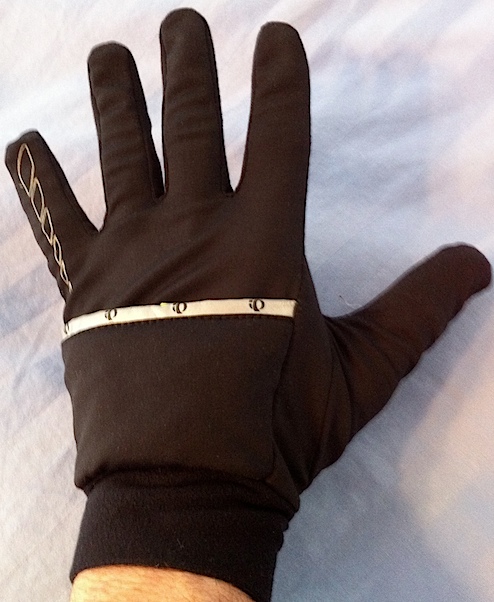
It’s a nice, lightweight glove with good tacky grip on the palms and lightweight insulation on the back.
So, what’s so special about these?
Well, that reflective stripe on the back of the glove is actually a pouch, containing an attached (so it can’t be separated or dropped) lightweight nylon pocket that slides over your fingers, changing the gloves into mittens in less than two seconds:
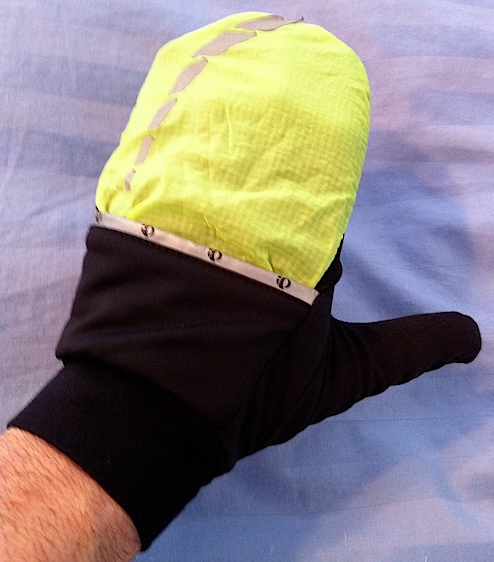
And here’s what this looks like from the palm view:
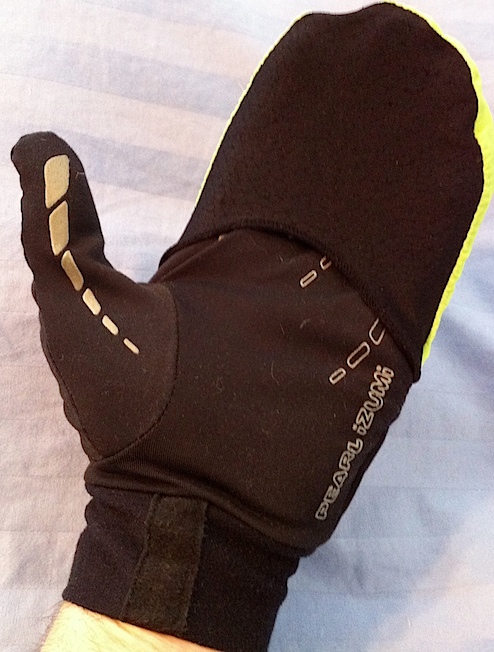
And they can be converted back into mittens just as easily and instantly. Here’s how the glove looks with the mitten part stuffed partway back in the pouch on the back of the glove, so you can see where the mitten pocket goes:
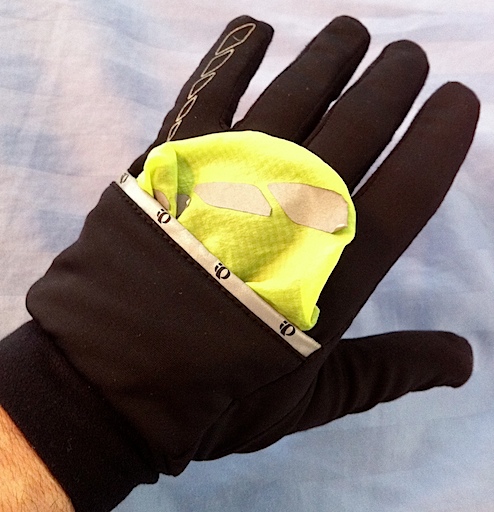
The Gimmick is Not Gimmicky
You might think that a thin little nylon mitten stretched over your glove wouldn’t make much of a difference, but you’d be wrong. That thing serves as a terrific windbreaker for your hand and makes a huge difference when you’re riding into a headwind.
It also does a great job of retaining heat, and is good for keeping your fingers at least a few degrees warmer than they otherwise would be.
And since that shell stuffs away into the glove, you can easily swap it on and off — while riding — as often during the ride (or, in The Runner’s case, during the run) as you like.
These gloves / mittens are, in short, an elegant and effective layering solution that have made my winter riding (and — I confess — running) hugely more pleasant. These are my go-to Fall/Winter gloves, and having used them frequently for about five months now (I bought them at Mellow Johnny’s during the Austin LiveStrong Challenge and have been using them at least twice a week since), I can wholeheartedly say I love these gloves.
And The Runner feels just the same way about hers.
And Now for the Sad Part
As part of the extensive research I did for this post, I went to the Pearl Izumi site, so I could link to these gloves.
But they aren’t there. They used to be, but they aren’t anymore.
So I left a voicemail with Pearl Izumi asking them to call me back and tell me if I’m not looking in the right place.
Heck, I even tweeted, asking if anyone knew where to find these gloves. Nobody has replied.
But honestly, as soon as I searched the Pearl Izumi site and came up empty-handed, I knew what had happened: these gloves I love have been discontinued.
I would express my surprise, if it weren’t for the fact that I’m not even remotely surprised.
It’s a simple manifestation of what I shall hereby dub the “Discontinuance Principle:” I.e., the likelihood of a product being removed from the market is in direct proportion to how much you like that product.
This has happened to me countless times, with products ranging from breakfast cereals to magazines to soft drinks.
And now, of course, to a pair of very useful gloves.
But you know, I wouldn’t even mind so much except that now that I know these gloves are no longer for sale, another principle will come into play: “The Irreplaceability Effect.” Specifically, the likelihood of an item being destroyed or lost is in inverse proportion to the ease with which that item can be replaced.”
Too bad, too. I really love these gloves.
And Now for the Happy (And Kinda Embarrassing) Part that Follows the Sad Part
Almost the very instant I posted today’s entry, Lana commented with the name of the gloves. They’re called “Shine Wind Mitt Gloves,” evidently. Which is a mouthful, but that’s not the point. The point is that armed with that knowledge, it took all of three seconds to find that these gloves are in fact still available from Pearl Izumi, right here at this here web page.
Trying to figure out how I possibly missed seeing these gloves, I tried to reconstruct my problem. My problem, as it turns out, is that I went to the top-ranked promoted site Pearl Izumi advertises (shop.pearlizumi.com), which does not have the gloves. However, their more current, updated site does of course have these gloves.
In short, if you want a pair of these gloves I like so much, go here, or just search for “Pearl Izumi Shine Wind Mitt” at your favorite retailer.
Thank you. I am now going to go take a nap.
PS: Be sure to check out the new header photo today, sent in by StuckInMyPedals — a photo of her and her brother Pete. Photo courtesy of Chris Flentye.
Comments (41)
03.7.2011 | 12:31 pm
The Runner and I just got back from a little trip to Zion National Park, celebrating our one-year anniversary. We stayed in a little cabin that’s actually inside the park: wood floor, gas fireplace, and a beautiful view.
We went on two runs, two hikes, and two bike rides. And ate ourselves silly. For a couple that loves the outdoors and wants a reasonably-priced, uncrowded romantic getaway, I highly recommend late winter in the cabins in Zion National Park.
What was really great about the stay, though, was that our cabin had no phone (including no mobile phone reception) or TV. I had time to think. And to let my thoughts settle.
And at some point during this trip, everything came together. The Big Idea I’ve had swirling around in my mind — creating a Caretaker’s Companion book and companion website — gelled into an actual plan.
I went from thinking about “someday” to “ASAP.” Because this is the thing I think I can do in my lifetime that will actually make a difference in the world. And I believe my personal and work experience have given me what may be a unique ability to create something that can improve the lives of thousands of people.
And — since I’ve never been one for keeping cards close to my vest — I’m going to lay out what I want to do and the things I need to do it.
And I would love your feedback, because this is still early stages, and I would love to get your good ideas on how to make this plan better and make it work well.
The Elevator Pitch
When you have cancer, it takes everything you’ve got to simply fight that cancer. It falls to your caretaker — a loved one who wants you to give that fight everything you’ve got — to take care of everything else: your doctors, your food, your comfort, your wellwishers, your medicine, everything. And like millions of other people who have been caretakers of loved ones with cancer, I know that the job of being a caretaker can be overwhelming.
It can also, if you know how to approach the job, the most rewarding thing you have ever done.
I want to write a book called The Cancer Caretaker’s Companion. This book will combine the lessons, questions, tips, tricks, advice and inspirational stories from approximately 25 people (including myself) who have been the primary caretaker of a person with cancer.
The wisdom of these caretakers’ experience — gleaned from dozens of in-person interviews — will be combined with the expertise of people who see and help caretakers on a daily basis: oncologists, nurses, insurance professionals, dietitians and more.
By reading this book — and visiting the companion Cancer Caretaker Community website — caretakers will learn invaluable techniques for helping their loved ones during — and beyond — treatment, learn the right questions to ask doctors and nurses, and get the invaluable support and inspiration from others who have been there.
The caretaker has the most important job in the world when they are helping a loved one fight cancer. The Cancer Caretaker’s Companion will help them do that job better and easier.
Why I am the Right Person to Write this Book
There’s no question in my mind that this book needs to be written, nor that there is pent-up demand for this book. For every person fighting cancer, there’s another person giving them the support they need to engage that fight fully.
There are three reasons, however, why I’m the perfect person to write this book.
- I have personal experience. I have lived through the process of being a caretaker. For five years, I was my wife’s caretaker as she battled breast cancer. I have learned hundreds of valuable lessons and want to share them. This matters to me.
- I have professional experience. I will create this book using techniques similar to how I do my day job at an IT research company. I find people to talk with, interview them, extract the key learnings from those interviews, and work with teams of experts to interpret and organize the insights we have uncovered. This will not be a book based on one person’s recollections; it will be a thoroughly, expertly researched book with guidance from both caretakers and professionals, conducted by a person (me) who does this for a living.
- I am a writer. My experience both with cancer and research could make for a tragic book or a dry book, but they won’t. I have experience both as a professional writer and editor, and the style I will bring to this book will be the same conversational style I bring to the blog that has won “Best Sports Blog” (three times) and “Lifetime Achievement” awards. In short, this book will not just be helpful, it will be uplifting and readable.
What I’m Going to Do, and What I Need to Do It
To make this book happen, here’s what I imagine myself doing.
- Complete the first Best of Fatty book. I’ve outlined three volumes for The Best of Fatty. Yes, really. Before I do much of anything else, I need to get at least the first one complete and see if I can get some pre-orders going for it. Why? Because building the Caretaker’s Companion site and interviewing dozens of people in person (for something like this, phone calls won’t do) is going to cost me a bundle. I need money to gather the wisdom this book needs.
- Launch the Caretaker’s Companion site. I’ll need people who are willing to help me get this site off the ground; it will be more sophisticated than a blog. I’ll need help with design and coding, at the very least.
- Assemble a team. While I’ll be writing this book myself, I will assemble a team of people to lend their professional advice, in order to supplement what I’ll learn from caretakers themselves. Initially, I’m thinking an oncologist, a nurse that works with an oncologist, a hospice nurse, a radiologist, a dietitian that has worked with cancer patients, and an insurance professional. But I would love to hear ideas of other professionals you’d like insights from.
- Find partners. I’m hopeful that LiveStrong will work with me on this book — both for finding people to participate, and in promoting the book itself.
- Find a publisher. I’ll need a publisher who has the vision to support this book, long-term and through multiple editions. If you’re with a publisher and you think we’re a good fit, please email me.
- Get interviewing and writing. Once I have the pieces in place, the actual work of researching, interpreting, and consolidating what caretakers know is something I’m good at. And writing is something I know how to do.
I kind of feel like a big chunk of the experiences in my life have led me to this point. I understand an important problem, I have the tools and experience to study and learn how to help others who have this problem, and I am lucky enough to be a good enough writer to tell the stories and give the guidance well.
I have to say, I’m incredibly excited to have a vision of something I can do to make the world a better place.
I can hardly wait to get to work.
Comments (112)
« Previous Page — « Previous Entries Next Entries » — Next Page »


 A Note from Fatty: This is the third in the occasional “The Fat Cyclist Explains” series, which goes to show it really is a series, albeit a sporadic one. You can read the
A Note from Fatty: This is the third in the occasional “The Fat Cyclist Explains” series, which goes to show it really is a series, albeit a sporadic one. You can read the 




